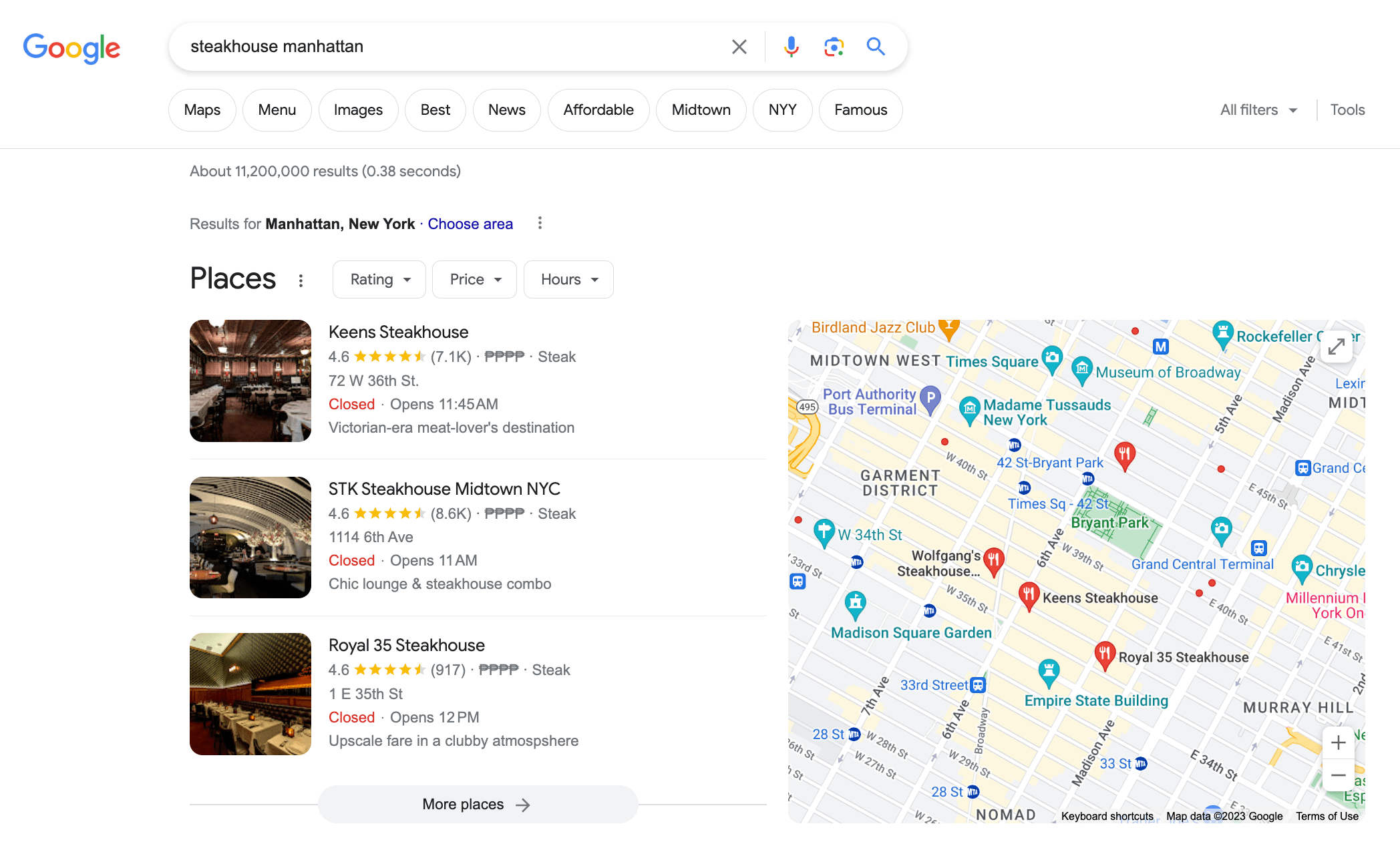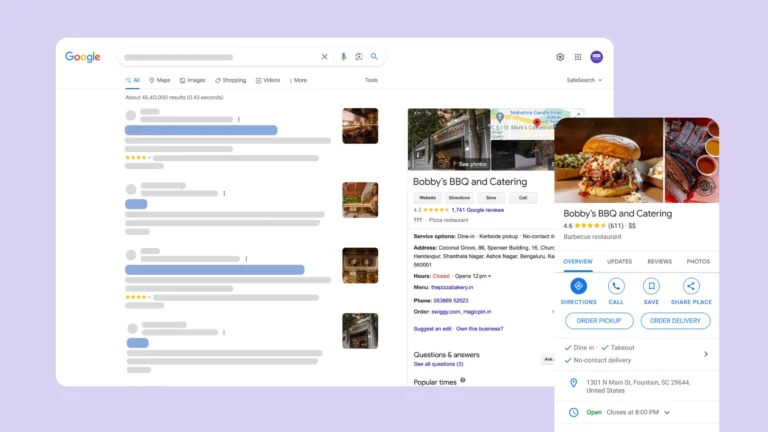
August 21st, 2024
Promoting your restaurant on Google isn’t just an option – it’s essential. With over 90% of consumers using search engines to find local businesses and 77% of diners checking out a restaurant’s website before making a reservation, having a strong presence on Google can be the difference between lineups or empty tables.
46% of all Google searches are seeking local information, highlighting the importance of optimizing your restaurant for local search. Whether you’re looking to attract new customers or engage with loyal patrons, mastering Google’s tools and strategies can significantly boost your visibility and drive more foot traffic to your restaurant. Here are the top ten things you must do to get the most of our Google for your restaurant.

Claiming and optimizing your Google Business Profile (formerly Google My Business) is a crucial first step in promoting your restaurant on Google. This free tool allows you to manage how your restaurant appears in Google Search and Maps, ensuring that potential customers find accurate and appealing information about your establishment. According to Google, businesses that verify and update their information on Google are twice as likely to be considered reputable by consumers. Claiming your profile is simple – just search for your restaurant on Google and follow the prompts to claim or create your listing.
Once claimed, optimizing your Google Business Profile is key to standing out in local searches. Start by ensuring that all basic information – such as your restaurant’s name, address, phone number, and website – is complete and accurate. Restaurants that provide accurate and detailed business information are 70% more likely to attract walk in customers. Additionally, selecting the appropriate business categories and attributes can help Google connect your restaurant with potential diners searching for specific types of cuisine, dining experiences, or services.
Beyond the basics, you can enhance your profile by adding high-quality photos of your menu items, interior, and exterior. Google reports that businesses with photos receive 42% more requests for directions and 35% more clicks to their websites. Regularly updating your profile with new photos, special offers, and relevant updates keeps your listing fresh and engaging, which can lead to increased visibility in local search results and ultimately drive more traffic to your restaurant.
Customer reviews play a vital role in shaping your restaurant’s reputation on Google. Not only do they influence potential diners’ decisions, but they also impact your restaurant’s local search ranking. According to BrightLocal, 87% of consumers read online reviews for local businesses, with 79% trusting them as much as personal recommendations. Positive reviews can serve as powerful endorsements, helping to build trust and attract more customers to your restaurant.
To encourage more reviews, consider making it easy and rewarding for customers to share their experiences. After dining, you can politely ask patrons to leave a review or include a direct link to your Google Business Profile in follow-up emails or on receipts. Research shows that businesses with a higher number of reviews rank higher in local search results, and even a small increase in your review count can lead to a noticeable boost in visibility. Additionally, restaurants that actively engage with their reviewers – by responding to both positive and negative feedback -are seen as 1.7 times more trustworthy than those that do not.
Managing customer reviews is just as important as encouraging them. Promptly respond to reviews to show customers that you value their feedback and are committed to providing excellent service. When responding to negative reviews, be professional and solution-oriented—this can help mitigate the impact of a poor review and may even win back a dissatisfied customer. Moreover, Google’s algorithm takes into account the recency and frequency of reviews, so regularly receiving and managing reviews will help maintain and improve your restaurant’s online reputation, leading to increased foot traffic and higher sales.

Google Ads can be a powerful tool for promoting your restaurant, offering targeted advertising that reaches potential customers precisely when they’re searching for dining options. With Google Ads, you can create customized campaigns that appear in Google Search results, on YouTube, and across the Google Display Network, ensuring your restaurant is visible to the right audience at the right time. On average, businesses make $2 in revenue for every $1 spent on Google Ads, demonstrating its effectiveness in driving customer engagement and sales.
When setting up your Google Ads campaign, start by choosing the right keywords – those that align with what potential diners might be searching for, such as “best Italian restaurant near me” or “vegan brunch spots.” Google’s keyword planner can help you identify popular search terms relevant to your restaurant. Using location-based targeting is crucial for restaurants, as it ensures your ads reach people who are nearby and likely to visit. Local campaigns on Google Ads, specifically designed for businesses with physical locations, can increase your restaurant’s foot traffic by prominently displaying your ads across various Google platforms, including Maps.
To maximize the effectiveness of your Google Ads, monitor and optimize your campaigns regularly. Analyze metrics such as click-through rates (CTR), conversion rates, and cost per acquisition (CPA) to understand how well your ads are performing. Adjust your bids, ad copy, and targeting settings based on these insights to improve results. According to Google, ads on the first page of search results receive 91% of all search traffic clicks, making continuous optimization critical for ensuring your restaurant remains competitive in the local market. By effectively utilizing Google Ads, you can attract more diners, increase reservations, and boost your restaurant’s overall visibility.
Google Maps is a crucial platform for restaurant visibility, as it directly connects your establishment with nearby customers searching for places to eat. With over 1 billion active users, Google Maps is a primary tool for people looking for local dining options. In fact, 86% of people use Google Maps to find local businesses, and restaurants that are highly visible on this platform are more likely to attract visits from customers nearby.
To enhance your restaurant’s visibility on Google Maps, it’s essential to ensure that your location information is accurate and up-to-date. This includes your address, phone number, hours of operation, and any special attributes like delivery or outdoor seating. Accurate listings are 70% more likely to attract walk ins, while incorrect information can lead to frustration and missed opportunities. Additionally, using specific keywords in your Google Business Profile can improve your ranking in “near me” searches, helping your restaurant appear more prominently when users are searching for dining options in the area.
Leveraging Google Maps features like photos, reviews, and Q&A can further boost your visibility. High-quality images of your restaurant’s interior, exterior, and popular dishes can entice users to choose your restaurant over others. Businesses with more photos receive 42% more requests for directions on Google Maps, demonstrating the power of visual appeal. Encouraging satisfied customers to leave reviews on your Google Business Profile also plays a significant role in your ranking on Google Maps, as well-reviewed establishments are more likely to be highlighted in local searches.
Google Posts offer a unique way to engage with potential customers by sharing timely and relevant content directly on your Google Business Profile. These posts appear in Google Search and Maps, giving you an additional opportunity to capture the attention of diners as they search for local restaurants. According to Google, businesses that regularly update their profiles with posts can see a significant increase in user interactions, including clicks and calls. In fact, restaurants that utilize Google Posts effectively can drive up to 35% more traffic to their website and increase in-person visits.
To create engaging Google Posts, focus on content that resonates with your audience and highlights what makes your restaurant unique. This could include promoting special events, seasonal menus, limited-time offers, or behind-the-scenes looks at your culinary process. Visual content is particularly powerful; posts with images or videos receive higher engagement rates than text-only posts. For example, sharing a mouth-watering photo of a new dish or a short video showcasing your chef in action can entice potential diners to visit your restaurant.
Consistency is key when it comes to using Google Posts. Regularly updating your profile with fresh content keeps your restaurant at the forefront of search results and signals to Google that your business is active and engaged with its customers. Additionally, Google Posts can include call-to-action buttons such as “Order Online,” “Call Now,” or “Book a Table,” making it easy for users to take the next step directly from the post. By strategically using Google Posts, you can enhance your restaurant’s online presence, increase customer engagement, and drive more traffic both online and in-store.
Optimizing your restaurant’s website for local SEO is essential for increasing your visibility in search engine results and attracting more local diners. Local SEO ensures that your restaurant appears prominently in search results when potential customers look for dining options in your area. Considering that 78% of location-based mobile searches result in an offline purchase, having a well-optimized website can significantly boost your foot traffic and reservations.
To start, ensure that your website includes accurate and consistent information about your restaurant, such as your name, address, phone number, and business hours – this is often referred to as NAP (Name, Address, Phone). Search engines prioritize websites with consistent NAP information across all platforms, helping you rank higher in local search results. Additionally, integrating local keywords into your website’s content, such as “best sushi in [city]” or “downtown [city] vegan restaurant,” can further improve your chances of appearing in relevant local searches. According to Google, websites that optimize for local search can experience a 200% increase in page views.
Mobile optimization is another critical component of local SEO. With 61% of all Google searches happening on mobile devices, your website must be mobile-friendly to ensure a smooth and accessible experience for users. This includes fast loading times, easy navigation, and clear call-to-action buttons, like “Order Now” or “Make a Reservation.” A responsive and well-optimized mobile site not only enhances user experience but also positively impacts your local search ranking. By focusing on local SEO, you can ensure your restaurant stands out in search results, driving more local customers to your website and ultimately to your tables.

Leveraging Google Analytics and Search Console is essential for understanding your restaurant’s online performance and optimizing your digital marketing efforts. Google Analytics provides detailed insights into how users interact with your website, including which pages they visit, how long they stay, and what actions they take. These insights are invaluable for identifying which aspects of your website and online presence are driving traffic and conversions.
Google Search Console complements Google Analytics by offering specific insights into how your restaurant appears in Google Search. It provides data on your website’s search traffic, including the queries that lead users to your site, your site’s ranking for those queries, and the click-through rates (CTR) for each keyword. Understanding this data allows you to optimize your content and SEO strategies more effectively. For instance, if you notice that a particular keyword or dish is driving significant traffic, you can create more content around that topic to capture even more search interest. Additionally, Search Console alerts you to any technical issues affecting your site’s performance, such as mobile usability problems or indexing errors, which you can quickly address to maintain or improve your search ranking.
By regularly analyzing data from Google Analytics and Search Console, you can refine your promotional strategies to better target your audience and meet their needs. For example, if analytics show that most visitors are accessing your site during lunch hours, you could run time-sensitive promotions or specials during that period. Similarly, if Search Console reveals that certain keywords are underperforming, you can adjust your SEO tactics to improve those rankings. According to HubSpot, businesses that use data-driven marketing are six times more likely to achieve a competitive advantage.
Implementing structured data markup on your restaurant’s website is a powerful way to enhance your visibility in search engine results and provide potential customers with detailed, easily accessible information. Structured data, also known as schema markup, is a type of code that helps search engines understand the content on your website and present it in a more informative and visually appealing way. For restaurants, this could mean having your menu items, reviews, business hours, and location appear directly in search results as rich snippets, making your listing more attractive to potential diners.
To get started, focus on marking up key information that customers commonly seek when searching for restaurants, such as your menu, operating hours, and special events. For example, using structured data to display your menu in search results can provide potential customers with a sneak peek of what you offer, encouraging them to visit your restaurant. According to a study by Moz, websites with rich snippets receive a 20-30% increase in click-through rates compared to those without, highlighting the importance of implementing structured data.
Structured data markup also improves your chances of appearing in Google’s Knowledge Graph, a feature that provides a summary of information about your restaurant on the right side of search results. Being featured in the Knowledge Graph can further increase your restaurant’s visibility and authority, especially for branded searches.

Local influencers, who have a strong following in your area, can introduce your restaurant to a broader audience through social media posts, reviews, and recommendations. In fact, 49% of consumers depend on influencer recommendations, making this a powerful tool for driving new customers to your restaurant. By partnering with influencers who align with your brand, you can create authentic content that resonates with their followers and enhances your restaurant’s reputation.
In addition to social media influencers, collaborating with local food blogs and online publications can further increase your restaurant’s online presence. When your restaurant is featured in a well-read local blog, it not only reaches the blog’s readership but also gains valuable backlinks that improve your website’s SEO. These collaborations can drive more organic traffic to your website and improve your ranking in local search results, making it easier for potential customers to discover your restaurant.
To maximize the impact of these collaborations, choose influencers and blogs that cater to your target audience, whether it’s foodies, families, or health-conscious diners. Offer exclusive experiences, such as menu tastings or behind-the-scenes tours, which they can share with their followers. These unique experiences create engaging content and generate buzz around your restaurant. Research shows that 82% of consumers trust local influencers and bloggers more than traditional ads, which means that these partnerships can have a lasting impact on your restaurant’s visibility and customer engagement.
Regularly reviewing your performance metrics helps you stay ahead of these changes and ensures that your marketing efforts remain effective. According to a study by HubSpot, companies that monitor and adjust their strategies regularly see a 30% higher growth rate in website traffic and a 25% increase in lead generation compared to those that don’t.
Google Analytics and Google Search Console are invaluable tools for tracking your website’s performance and identifying areas for improvement. By analyzing key metrics such as traffic sources, user behavior, and conversion rates, you can gain insights into which aspects of your strategy are working and which need adjustment. For example, if analytics reveal a drop in traffic from certain keywords, you may need to refine your SEO efforts or update your content.
Adapting your strategy based on these insights is crucial for sustained success. Regularly updating your Google Ads campaigns, optimizing your Google Business Profile, and refreshing your Google Posts based on performance data can keep your restaurant’s online presence competitive. Research shows that businesses that proactively adjust their digital marketing strategies based on performance data see up to a 50% increase in return on investment (ROI).
Promoting your restaurant on Google involves a multifaceted approach, from optimizing your Google Business Profile and leveraging local SEO to engaging with customers through reviews and targeted ads. By continuously monitoring your performance and adapting your strategy, you can effectively boost your restaurant’s online visibility and attract more diners.